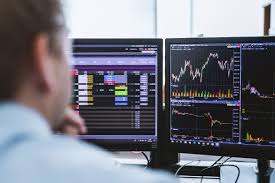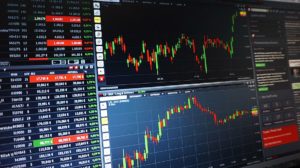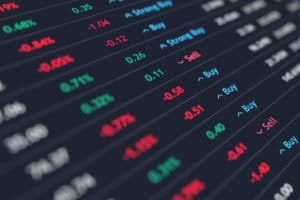Algorithmic Trading UK Guide 2025
Our algorithmic trading UK guide explains how automated trading, bots, signals and strategies work, reviews trading software and compares the various providers and brokers on the market. Read on to see how the world of computer-driven trading could give your trading the edge, while avoiding the pitfalls.
Algorithmic trading is increasingly popular in the UK and worldwide Many beginners and experienced traders are using automated trading platforms UK investors are accepted at. We review the ins and outs of automated trading in 2022.
-
-
Key Points on Auto Trading
- Algorithmic trading, also known as automated trading, involves setting trade entry and exit parameters for algorithms to follow on your behalf.
- One well-known Bitcoin automated trading platform UK wise claims to have accuracy and success rates above 70%.
- The most appealing factor when it comes to automated trading is that it eliminates the emotional side of investing.
What is Algorithmic Trading?

Algorithmic trading is the name given for computer-driven automated trading programs used to execute orders.
A program will act on a series of inputs provided by the trader as a set of rules and instructions (algorithm) to be carried out under set conditions and times.
Programmed technical analysis
Technical analysis can be expressed programmatically with triggers for price events that lead to order executions or generate signals.
It is your choice how much control you want to have over the process – take a passive approach where you are happy to let the programs run with minimal oversight; or a more active approach, both in creating and refining algorithms and intervening to alter program responses.
Algorithmic trading – sometimes called automated trading, algo trading, or ‘black box’ trading – was once only available to financial institutions with the resources and expertise to build and deploy computer programs for trading. That’s not the case anymore.
Algorithmic trading software in the hands of retail investors evens up the score among market participants. Algo trading is the bread and butter of day traders.
Advantages of Algorithmic Trading
The advantage of using automated or blackbox trading is the speed at which trades can be made and the number of simultaneous orders that can be made.
Algo trading is the software foundation of rules-based quantitative investment strategies and high-frequency trading (HFT). Automated trading brings ‘quant’ investing to the retail investor. Armed with quant analysis and inputs and lightning-fast hardware positioned close to exchanges, trading firms seek out critical time advantages and pricing anomalies and spreads.
Pro power
With the power of algo, ordinary investors can do the same, even if they don’t have quite the same power in the hardware department.
You don’t need to be a professional trader at a Chicago trading house sitting on billions of dollars in state-of-the-art infrastructure and kit to leverage the advantages of algorithmic trading, even if the small fry can’t compete at the microsecond level with the pros, you can steal a march on the rest of the retail crowd.
Bottom line, computers are faster than people – order execution is measured in milliseconds (a thousandth of a minute) and microseconds (a thousandth of a millisecond).
UK Algorithmic Trading Software
Algo trading software comes in many forms and with varying levels of sophistication. Naturally, the more power and control you want, the more you will have to pay.
We have broken down the auto trading software scene into four groupings: bots, trading signals, copy trading, and platforms.
Bots
Auto-trading robots – also known as expert advisers – will continuously watch for certain event conditions to be met to execute a trade, including all types of order information such as stop-loss and take-profit orders. Bots were first embraced in the forex trading community for automating the trading of currency pairs but are now available across asset classes.
Semi-automated
If you want more control over the trading, you could opt for a semi-automated option. The robot will conduct necessary research as required and technical analysis. Relative strength indicator and MACD (Moving Average Convergence Divergence indicator) are commonly used inputs along with the 200-day, 100-day, and 50-day moving averages.
Trading signals
Trading signals are more about the research side of trading. Investors can think of a signal as something you plug into a bot, although the terms bot and signals are often used interchangeably.
Signals are based on technical analysis or a human analyst and can be delivered to the end customer in a number of ways. But whether it is an email newsletter or a Telegram chat room, signals will cost you.
The generator of the signals will be using similar algorithms as the bots but with the difference that the signals don’t take action.
A trading signal service might work as follows:
- Buy a forex signal service for currency pairs
- The provider sends you a real-time signal when an algorithm finds a trading opportunity
- Signal sends the following data: currency pair, buy or sell, entry price
- Other signal output data: stop-loss and take-profit order
After receiving the information it is the responsibility of the client recipient to act on it in a timely fashion.
Platforms
Not strictly software but the packages available from broker platforms bring together bots, signals, and strategies all under one roof.
One such example comes from broker Europefx, with its RoboX brand that specialises in smart trading strategies.
Answer a simple questionnaire and then see your answers used to create personalised trading strategies, courtesy of the proprietary Tradency algorithm. The algo scans a database stuffed with more than a billion trading strategies. Profitable trading strategies are suggested in real-time and matched to your trading profile.
Algorithmic Trading Strategies
Arbitrage trading
Arbitrage trading seeks to profit from small anomalies and discrepancies in prices at different trading venues or through other mispricing events. Opportunities for arbitrage trading appear and disappear quickly and the amounts involved can seem small. But with automated trading you have the ability to scan in real-time for the opportunities and, equally importantly, to execute multiple trades at once.
A simple example would be:
- Apple shares having a buy price of $100.50 on Broker 1
- Apple shares having a selling price of $100.55 on Broker 2
Imagine trying to grab this and similar arbitrage opportunities across the market without using programming. Think of all those brokers with slightly different prices reflecting their own order books, and then multiply that by the thousands of financial instruments out there, and one can see why this is a job well suited to algorithmic trading.
Trend Strategy
As it says on the tin, this strategy looks to follow market trends and cycles – it is also referred to as momentum investing. That is to say, if an asset is enjoying a prolonged period of bullishness, the algorithmic trading system will look to follow the trend by placing a buy order. Similarly, if an asset is in a bearish cycle, the algorithmic will place a sell order. Price movements, in this case, that go against the upward trend would be taken as buy signals.
Having said that, executing a trend strategy profitably is not easy, which is why software has found an increasingly important role alongside technical indicators and machine learning technologies. It will specifically analyse metrics such as channel breakouts and moving averages.
Then, on the balance of probabilities, the algorithm will determine which way the asset is likely to move in the short run. Naturally, the trend strategy employed by the software won’t always get its prediction right. As such, each trade will have an exit plan in place – notably in the form of stop-loss orders.
Is Algorithmic Trading Profitable?
Most people lose money trading. The algortihmic trading UK scene will have its cast of high-rolling losers just as any other country or trading technique.
Many of the brokers involved in providing software or acting as vendors and service operators on behalf of their own platforms are from the CFD broking community. Around 70% of CFD traders lose money. But it should be stated that not all of those traders will necessarily be algo traders. Nevertheless, that seems like a steep hill of losses to climb or to stay in the 30% of winners.
Notwithstanding the CFD aspect, algorithmic trading software packages do claim high success rates (percentage of trades closed in profit) for their blogs but don’t take these at face value without further investigation such as looking up reviews.
Algorithmic Trading Python
Algorithmic trading software is typically built using a specific programming language. The most popular one is Python, a flexible language with frameworks (libraries of code for particular groups of tasks) to meet the requirements of an autonomous trading system.
Learning to program in Python would be a benefit to designing your own bots. Other popular languages include C++, java, and .NET.
The overarching objective of the algorithm is to outperform the markets. To achieve this end, it must analyse millions of potential trading outcomes every second – and millisecond – on a rolling 24/7 basis across thousands of financial instruments.
As such, the scope for programming the analysis of the patterns and curves created by stock prices, trading volume, and other metrics, is eminently suited to the logic-crunching of software algorithms.
Python has established itself as one route for those looking for a ground-up approach to building bots and/or interested in improving on the algo efforts of others in the trading community.
Algorithmic Trading Platforms UK
1. AvaTrade (via MT4/5)
Another automated trading platform UK traders can use is AvaTrade. It provides MT4 as well as MT5 and its own proprietary AvaTradeAct platform.
The minimum deposit is $100 and markets cover stocks, indices, commodities, bonds, and cryptocurrencies (via CFDs), and forex (more than 50 currency pairs).
This fully regulated platform does not provide trading signals but has the full breadth of auto trading software, from MetaTrader4 to Duplitrade, RoboX, Mirror Trader, and MQL5, to get your forex robots up, running, and making money.
Sponsored ad. 71% of retail investor accounts lose money when trading CFDs with this provider.
Telephone customer support
When going through our automated trading platform reviews we found that AvaTrade offers worldwide telephone support coverage. This shows a welcome commitment to customer service.
The company is regulated by financial authorities in Ireland, South Africa, Australia, and Japan.
Withdrawals to credit and debit cards take up to five days, wire transfer 10 days, and 24-hours for e-wallets.
Leverage is available depending on jurisdiction/market.
2. IG (MT4, pro-real-time, native APIs)
Another autotrading platform platform comes from the investment and trading platform IG. In common with the rest of the retail automated trading platforms UK, IG uses the MetaTrader 4 (MT4) trading software and ProRealTime for charting.
Ubiquitous MT4
MT4 is used by many brokers – especially in forex – because of its market penetration built up over the years which means it has a community of traders continually improving on the algos available to purchase at the platform’s marketplace. MetaTrader 4 is often used for automated forex trading UK wise. MT4 started life in 2005, founded by Metaquotes. For more on MetaTrader 4 trading platforms you can read our MT4 brokers guide.
18 indicators bundled with a package
Handily, IG bundles 18 indicators and add-ons when you download MT4 from them, so you don’t have to buy them on the marketplace.
In addition to MT4, IG also offers the ProRealTime charting package which it rightly flags as one way to get started with making your own algos. ProRealTime comes with an optimisation suite where you can carry out the all-important backtesting of algorithms. Backtesting is the technique where the program is run on historical data price series where the trades and signals can be scored for returns generated.
API
The third leg of the IG service is its API – the software that enables computer services to interact, with examples for the types of data that can be sent, how requests for data are made, and so on. The application programming interface opens up IG’s market data and trading technology to clients’ own self-created algos but requires knowledge of computer programs and coding to fully utilise.
The service offers off-the-shelf automated trading UK or the option to craft your own to be executed as spread bets and CFD instruments.
Sponsored ad. 66% of retail investor accounts lose money when trading spread bets and CFDs with this provider.
3. FX Master Bot
Easy customisation of the algos is a key selling point of FXMasterBot. The entry ‘novice’ package costs $250 and comes with three currency pairs.
The MasterBot Expert account costs $500 and comes with a leader board multiplier x3. And nine currency pairs. Trades begin from a minimum amount of $25.
Deposits
The MasterBot Master account and the Expert both require minimum deposits of $500. The Master account provides 17 currency pairs and unlimited open positions.
Customers can switch between a number of brokers, including EuropeFX, 24Option, and iTrader.
There are no fees charged on FXMasterBot and the demo account provides an introduction for beginners.
Sponsored ad. Your capital is at risk.
4. Learn2Trade
This UK based company is popular with some cryptocurrency and FX traders. Signals and alerts are sent directly to your email or phone with an entry price level and chose to execute from one of the listed brokers, such as Avatrade.
A full array of technical analysis metrics can be plugged into the algos, from Fibonacci retracements to Bollinger bands and moving averages
The premium service starts at $35 a month but the value for money improves if you pay a larger amount less frequently – $65 for three months; $95 for six months. Premium also comes with free VIP signals for the year.
Free signals
Without paying anything at all, customers can receive three signals for free each week.
There is also a Telegram chat group that is free to join but the reliability of the signals and alerts is such that you will be pushed to paying for the premium service.
Learn2Trade is regulated by the UK Financial Conduct Authority.
Claimed win rate 82% with average monthly gains of between 30-40%.
Sponsored ad. Your capital is at risk.
Broker fees comparison table
Broker Product Cost Deposit Fees Minimum Deposit AvaTrade Variable spread Free £100 IG £0 – £10 if buying and selling, variable spread for CFDs Free (0.5%-1% on credit cards) £250 FX Master Bot Free to register Not specified $250 Learn 2 Trade From £14.16 per month (6-month plan) N/A N/A Tips for Algorithmic Trading
- A broker can claim all the success rates they like for their bots but unless they are verifiable that’s no use to the prospective customer. One way to verify success rates is by checking if traders have recorded their positions and earnings with a third party that allows public access. For example, linking trading accounts to myfxbooks would be a start and allow a customer to interrogate the accuracy of trading results.
- Reviews on platforms such as Trustpilot and elsewhere are a must before depositing funds with a broker or paying out for trading software. Some reviews will be false but you can control for that by seeking out the avenue that provides a decent sample size for reviews. A site proclaiming a score of 4 out of 5 stars on the basis of two reviews is not as helpful as 4 out of 5 from 20 reviews.
- Always start with a demo account. Even if you are relatively experienced, it is an idea to use the demo account so you can find yourself around the new trading venue.
- Go with a software vendor that provides a money-back guarantee or trial period.
- Full-spectrum trading – adopt different strategies with different platforms and an ix of asset classes. This will help to avoid situations in which all your trades fall foul to a problem unique to one bot. Traders should also trade across a variety of asset classes – diversifying in this way means, for example, if stocks go down one month, bonds or precious metals may have gone up.
- Algorithmic trading can be an intimidating subject to get to grips with. A useful book for beginners is authored by Ernest Chan, called Algorithmic Trading: Winning Strategies and Their Rationale. The book covers everything from backtesting to trading strategies. And for more depth on trading strategies check out Algorithmic Trading and DMA: An introduction to Direct Access Trading Strategies by Barry Johnson. (DMA stands for direct market access.)
- Udemy runs an algo trading course which is frequently the subject of special offers, so can cost as little as £13.99 (92% off the retail price). The course is a bit more of a deep dive for those at a beginner-intermediate level, with an introduction to programming in basic MQL4. But by the end of the course, you will have created your first bot from the bottom up.
Automated Trading Platform UK – Conclusion
This Algorithmic Trading UK Guide 2022 arms the growing crowd of investors turning to automated solutions with a comprehensive overview.
Automated trading is the closest the retail investor can get to the world of the hedge funds and trading firms’ “quant”-driven software systems and high-frequency trading computing power. Now ordinary investors too can take the emotion and psychology out of investment and trading decision making while those who want more control can find plenty of options for just that.
Provided you follow the sensible due diligence covered in this algorithmic trading UK guide it should keep you well away from the bad actors and criminals. Always check the address, registration, and regulatory authorisation of the provider, in particular, that it is regulation by the UK Financial Conduct Authority. Fully research your chosen platform or software before parting with your cash.
FAQs on Algorithmic Trading
How can I build an algorithmic trading system?
The process of building an algo trading system from the ground-up can take many years. Before you get to that stage, you will first need to have a solid understanding of programming languages like Python. You will also need to have a firm understanding of the wider financial markets.
Does algorithmic trading guarantee profit?
There are no guarantees that your chosen algo trading system will make you money. On the contrary, there is every chance that you will lose money.
How can I avoid algorithmic trading scams?
There are many steps that you can take to ensure you do not become a victim of an algo trading scam. This includes performing enhanced research on the provider, finding a way to verify their historical trading results, and testing the system out via a demo account.
What is algorithmic trading?
Algorithmic trading lets you build and customize your own trading algorithms, as well as use pre-built solutions. Algorithmic trading involves using computer software and trading bots to execute trades based on a set of rules like specific price movements in the forex or crypto markets. When the market conditions match your preferences, trading algorithms open and close positions on your behalf. This means you can save time and eliminate emotions from your investments.
How to learn algorithmic trading?
Some automated trading platforms such as IG allow you to trade with third-party algorithms including ProRealTime, APIs, and MT4. This means you can create and tailor your own algorithms or you can use off-the-shelf solutions. On the other hand, eToro also offers copy trading tools that allow you to trade passively. With eToro’s CopyTrader and CopyPortfolios you can copy the trades of other experienced traders with the click of a button. Additionally, you can even invest in pre-built CFD portfolios, saving you time and effort by eliminating the need to manually scan and monitor the current markets.
Gary McFarlane
Gary was the production editor for 15 years at highly regarded UK investment magazine Money Observer. He covered subjects as diverse as social trading and fixed income exchange traded funds. Gary initiated coverage of bitcoin and cryptocurrencies at Money Observer and for three years to July 2020 was the cryptocurrency analyst at the UK’s No. 2 investment platform Interactive Investor. In that role he provided expert commentary to a diverse number of newspapers, and other media outlets, including the Daily Telegraph, Evening Standard and the Sun. Gary has also written widely on cryptocurrencies for various industry publications, such as Coin Desk and The FinTech Times, City AM, Ethereum World News, and InsideBitcoins. Gary is the winner of Cryptocurrency Writer of the Year in the 2018 ADVFN International Awards.View all posts by Gary McFarlaneWARNING: The content on this site should not be considered investment advice and we are not authorised to provide investment advice. Nothing on this website is an endorsement or recommendation of a particular trading strategy or investment decision. The information on this website is general in nature, so you must consider the information in light of your objectives, financial situation and needs. Investing is speculative. When investing your capital is at risk. This site is not intended for use in jurisdictions in which the trading or investments described are prohibited and should only be used by such persons and in such ways as are legally permitted. Your investment may not qualify for investor protection in your country or state of residence, so please conduct your own due diligence or obtain advice where necessary. This website is free for you to use but we may receive a commission from the companies we feature on this site.
Buyshares.co.uk provides top quality insights through financial educational guides and video tutorials on how to buy shares and invest in stocks. We compare the top providers along with in-depth insights on their product offerings too. We do not advise or recommend any provider but are here to allow our reader to make informed decisions and proceed at their own responsibility. Contracts for Difference (“CFDs”) are leveraged products and carry a significant risk of loss to your capital. Please ensure you fully understand the risks and seek independent advice. By continuing to use this website you agree to our privacy policy.
Trading is risky and you might lose part, or all your capital invested. Information provided is for informational and educational purposes only and does not represent any type of financial advice and/or investment recommendation.
Crypto promotions on this site do not comply with the UK Financial Promotions Regime and is not intended for UK consumers.
BuyShares.co.uk © 2025 All Rights Reserved. UK Company No. 11705811.
We use cookies to ensure that we give you the best experience on our website. If you continue to use this site we will assume that you are happy with it.OkCookie PolicyScroll Up





